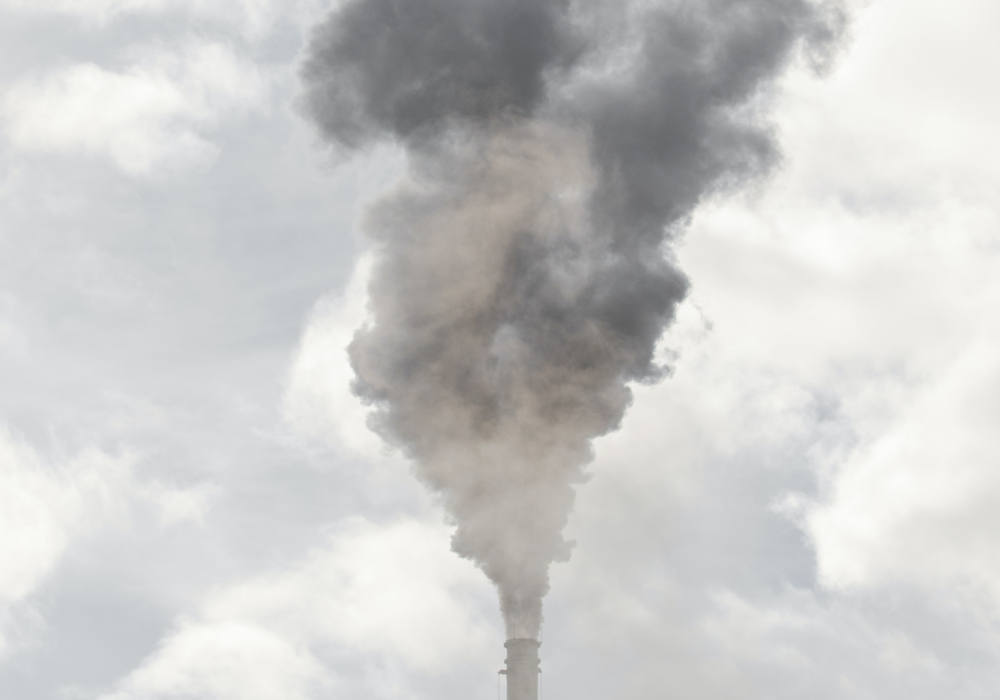
Smoke billows from a tower at the Holly Refining Co. petroleum refinery in Woods Cross, Utah in this 2018 photo. (Unsplash/Patrick Hendry)
Editor's Note: This story originally appeared in Grist and is part of Covering Climate Now, a global journalism collaboration strengthening coverage of the climate story.
What do you think of when you hear the word "pollution" — a city smothered in smog, a beach strewn with trash, factories pumping out dark clouds?
Now try to picture "carbon emissions." See anything? Probably not, since carbon dioxide is invisible.
This simple exercise helps explain the growing popularity of once-rare phrases like "carbon pollution" and "climate pollution" in place of "carbon emissions" or the older "greenhouse gases." Connecting climate change with something visceral and dangerous brings more immediacy to a problem that's often seen as unfolding far away or in the future, even though it's causing suffering now. "Climate pollution" is becoming common on the websites of green groups and atop news stories. "Carbon pollution" has been adopted by the Biden administration, appearing on the Environmental Protection Agency's site, in press releases about cleaning up manufacturing, and in speeches by the president.
"I think ‘pollution' is a better word to use than ‘emissions,' because everyone understands that pollution is harmful," said Susan Joy Hassol, the director of Climate Communication, a nonprofit for science outreach.
Positioning climate change as a pollution problem might have bigger consequences than you'd think. Consider the recent Supreme Court decision in West Virginia v. EPA at the end of June. The court's conservative majority ruled that the EPA can't implement sweeping regulations on carbon dioxide without the explicit approval of Congress. The ruling threatened the Biden administration's ability to make good on its pledges to tackle climate change. At least, until a month and a half later. The Inflation Reduction Act, the landmark climate legislation signed by President Joe Biden in August, amends the 1970 Clean Air Act to clearly identify greenhouse gas emissions as a form of air pollution. When it comes to the law, definitions mean everything.
It wasn't always a popular move to link global warming with air quality. Until recently, most environmental groups treated them as distinct problems. Environmental justice advocates, on the other hand, have argued that global emissions and local air pollution were inextricably linked and needed to be addressed together. Otherwise, they argued, climate legislation could actually impede efforts to clean up the air in communities saddled with pollution.

President Joe Biden hands the pen he used to sign the Democrats' landmark climate change and health care bill to Sen. Joe Manchin, D-W.Va., in the State Dining Room of the White House in Washington, Aug. 16. (AP/Susan Walsh)
Both the sources of climate change and its effects are linked to air pollution: Highway traffic means more planet-warming CO2 and dirty smog, and worsening wildfires mean people inhale more particulate matter. Over the past decade, more people have come around to seeing climate change as a threat to their health, not simply an "environmental" problem. Not only does connecting climate change to pollution make the problem relevant to people's lives, but it also makes acting on it more popular. Clean air isn't something just environmentalists want — basically everyone wants it.
To people who are skeptical that carbon dioxide could be considered pollution — after all, it's natural! We breathe it out! — Hassol would point out that we use pollution to describe all kinds of disturbances, such as glowing cities (light pollution) and roaring airplanes (noise pollution). "Warm water isn't a bad thing either, but if you're dumping from a cooling tower water that's too warm into a stream, it'll kill the fish and it's not allowed," she said. "People understand intuitively what pollution means — it's something that's harmful that you're introducing unnaturally into the environment. And so this perfectly fits that definition." To describe greenhouse gas emissions, Hassol likes the phrase "heat-trapping pollution," since people don't need special background knowledge to comprehend it.
People have deep anxieties about a poisoned environment: The pollution of rivers, oceans, and lakes has consistently numbered among Americans' top 10 fears, whereas climate change didn't make the cut in the most recent survey. Research has shown that framing climate change as a danger to public health increased people's support for taking action on emissions and made them feel more hopeful. A paper in 2010 found that people considered the potential health benefits of reducing emissions "particularly compelling." More recent research suggests that talking about air pollution rather than climate change increases people's support for regulating power plant emissions, especially among Republicans.
"No matter where you are on the political spectrum, Democrat, Republican, progressive, conservative, there's not a person out there that doesn't care about the health and well-being of their children and the people they care about," said Molly Kawahata, a former climate advisor to the Obama White House who now advises organizations on how to reframe the climate crisis. "Nothing is more personal to us than our personal health."
Young environmental activists march to the U.S. Capitol during a climate change protest in Washington, D.C., Oct. 15, 2021. Members of Gen Z, people born after 1996, generally consider global climate change an existential crisis. (CNS/Reuters/Evelyn Hockstein)
Framing climate change as an air quality problem also validates long-standing concerns from communities that are threatened by industrial pollution. Black, Hispanic, and Asian Americans are, on average, more likely to breathe polluted air than white people, regardless of income, according to a recent study. Largely because of the legacy of redlining, Black and Latino people are more likely to live near industrial sites and polluting highways, hazards that are associated with health problems of all kinds, including asthma, childhood cancer, and preterm births. "Communities of color are not just the most impacted by the effects of climate change, like climate-related disasters," Kawahata said. "They're also most impacted by the sources of the climate crisis, which are our electricity and transportation industries."
Polluters often try to turn public attention away from these industrial sources. Oil companies have been promoting the concept of your personal "carbon footprint" for more than two decades, a message that helps them deflect responsibility. This individual-focused narrative has become a big part of how people think and talk about climate change. "When people hear ‘climate change,' they don't necessarily think of fossil fuels right away," Kawahata said. "They think about taking planes and driving cars and they think about a lot of their personal behavior."
"Climate pollution," by contrast, conjures images of billowing smokestacks, putting the culpability back on industry. The pollution lens gels with the idea that the climate crisis requires big-picture solutions from governments and corporations, as more Americans are beginning to understand. "It really shows it's a systemic problem that affects everybody, and that to solve it, you need to solve it for everybody," Kawahata said.
One of the earliest signs that public health was a powerful framing for climate action? Polluting companies were worried that green groups would emphasize how greenhouse gas emissions would harm people's health.
In the mid-1990s, the Global Climate Coalition, a group of corporations working to stop environmental regulations, expressed concerns to their board when emerging research showed that a hotter planet would be hospitable to mosquitoes, leading to the spread of malaria and other tropical diseases. "[E]nvironmental organizations' activities suggests their strategy is shifting to one of focusing on a purported increase in the spread of dangerous and lethal diseases as a result of climate change," read the coalition's annual report from 1995. "This could have major ramifications for the GCC."
But the early climate movement was strangely resistant to including public health in its plans to tackle global warming, dismissing activists who tried to do so. In the early 2000s, people living in highly polluted areas of California led the push for tackling local air pollution and climate change together. They pointed out that the same smokestacks that were spewing carbon emissions into the atmosphere were also emitting pollutants that harmed their families' health more directly. Why not regulate greenhouse gas emissions and clean up air at the same time, accomplishing two important goals at once?
When California began developing climate legislation in the early 2000s, however, local air quality got de-prioritized. The state started to "divert staff, time, resources, money, and grants away from local pollution" and toward limiting carbon emissions, said Michael Méndez, a professor of environmental policy at the University of California, Irvine, who wrote the book Climate Change from the Streets: How Conflict and Collaboration Strengthen the Environmental Justice Movement.
The Phillips 66 Co.'s Los Angeles Refinery is seen in Carson, Calif., March 11, 2022. (CNS/Reuters/Bing Guan)
Over the next several years, activists fought to get policymakers and traditional environmental groups to address air pollution and climate change head-on. But many officials and economists balked at combining the two issues.
Consider the following comment from a 2006 panel on developing cap-and-trade programs at an environmental law conference in California. Dan Skopec, then undersecretary for the California Environmental Protection Agency, said that the challenge of global warming was so great that it should be the single focus of policies. "Using the umbrella of global warming to satisfy other agendas is really going to distract from the solution and create inefficiency," he said. "So, as we go forward, I hope that we can all focus this effort on the problem of reducing greenhouse gases and not try to solve everyone else's unsolvable problems in other areas."
Environmental justice activists in California tried to popularize the phrase "climate pollution" starting around 2012, according to Méndez. He recalls talking to a legislative advocate for the California Chamber of Commerce who was uneasy about that language, saying they were wary of lumping all types of pollution together since it broadened the scope of regulation and would reduce economic efficiency.
Around the same time, a legal battle began pushing the two issues together at the national level. Massachusetts and other states argued that the Environmental Protection Agency was required to regulate greenhouse gases from vehicles under the Clean Air Act. But the EPA, under President George W. Bush, refused to do so, saying that the Clean Air Act didn't give it that authority. The case eventually ended up in front of the Supreme Court, which ruled in 2007 that the EPA did have that power, since planet-warming emissions technically counted as "air pollutants." The court ordered the agency to review the evidence to see whether carbon emissions endangered public health — and after an extensive two-year review, the EPA found that it did.
The pollution-oriented way of talking about climate change eventually spread from California to the White House. When the Obama administration announced the Clean Power Plan to reduce carbon emissions from power plants in 2015, the press release highlighted the new "carbon pollution standards." Testing conducted by the White House showed that public health was the best frame for discussing the problem.
Over the course of the 2010s, the conflict between economic-focused climate advocates and grassroots organizations gradually softened, replaced by a spirit of collaboration, Méndez said. "I'm not trying to paint a rosy picture that all is good in terms of environmental justice in California, but those vicious fights over climate and environmental regulation are not as vicious anymore," he said. Politicians are getting on board with defining carbon dioxide as air pollution and folding air quality standards into climate policies. Consider the cap-and-trade bill that Washington state passed last year, which establishes a regulatory program to reduce pollution in areas with poor air quality.
This new emphasis is reflected in the language people are using, too: Google Ngram, which tracks how frequently words are used in books, shows a clear increase in both "climate pollution" and "carbon pollution" over the last decade.
"There has been a shift from opposing such approaches to embracing them now because they understand that it brings more people under the tent, and it makes the movement more powerful," Méndez said. "It motivates people and energizes people because it makes climate change real."






